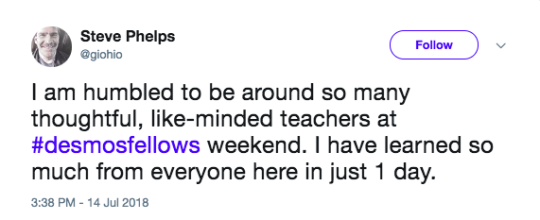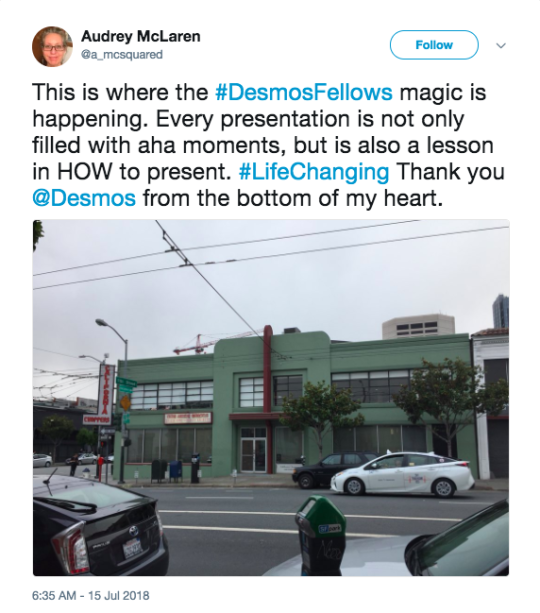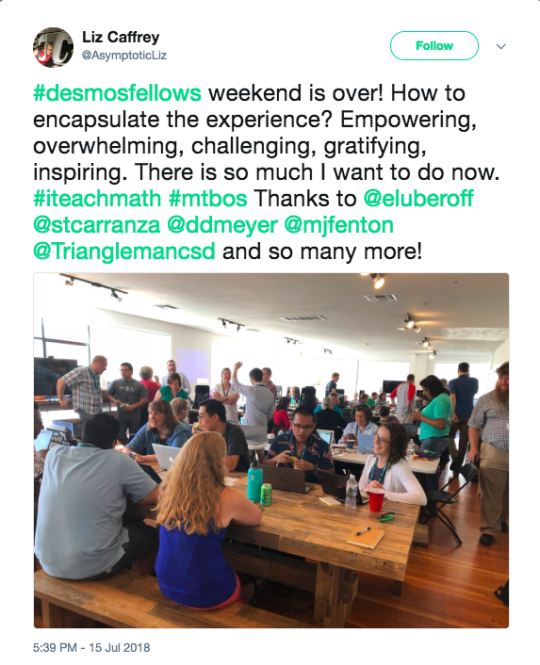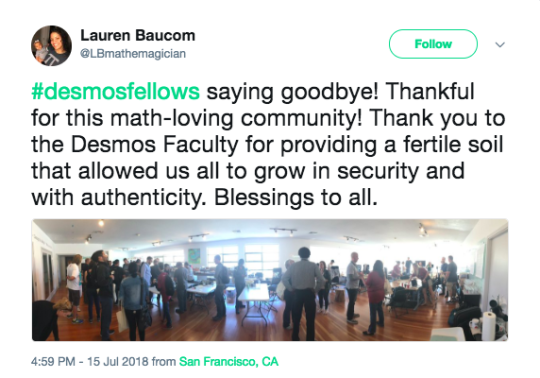Orchestrate More Productive Mathematics Discussions with Desmos Snapshots
Let me describe a powerful teaching tool we just released and the company
values that compelled us to build it.
First, let’s acknowledge that statements of values are often useless.
Values are only useful if they help people make hard decisions. Our company
values should (a) help educators decide how we’re different
from other math edtech companies, (b) help us decide how to spend our
limited time in the world. So here is one of our values:
We believe that math class should be social and
creative – that students should create mathematics in every
form and then share those creations with each other and their
teachers.
Many other companies disagree with those values, or at least they spend their
limited time in the world acting on different ones. For example, many
other companies think it’s sufficient for students to create multiple
choice and numerical responses to express their mathematical thinking and to
share those responses with a grading algorithm alone.
Our values conflict, and the result is that other companies spend their time
optimizing adaptive grading algorithms while we spend our time thinking about
ways to provoke mathematical creativity
that algorithms can’t grade at all. We may both work in “math
edtech” but we are on very different paths, and our path
recently led us to a very thorny question:
What should teachers do with all these expressions of mathematical
creativity that algorithms can’t grade?
Let’s say we ask students
an interesting question
about mathematics or we ask them to
define a relationship
and
sketch its graph. That’s good math, but the teacher now has dozens of written answers
and sketches that their computers can’t grade.
Other math edtech software offers teachers scarce insight into the
ways students think mathematically. We offer teachers
abundant insight which is a different kind of problem, and just as
serious. We’ve spent months building a solution to this problem of
abundance and we likely would have spent years if not for one
book:
Mary Kay Stein and Margaret Smith’s
Five Practices for Orchestrating Productive Mathematical Discussions.
Smith and Stein describe five teaching practices that promote student learning
through summary discussions. Teachers should (1) anticipate ideas
students will produce during a task or activity and then (2)
monitor student work during class for those ideas and others that
weren’t anticipated. Then the teacher should (3) select a
subset of those interesting student ideas, (4) sequence the order of
their presentation, and then help students (5)
connect them.
In our classroom observations of our activities, we noticed teachers
struggling to select student ideas because there were so many of them
streaming from the students’ heads into the teacher’s dashboard.
Sometimes teachers would make a note about an idea they wanted to select
later, but when “later” came around, the student had already
developed the idea further. So then we saw teachers take
screenshots of that idea and paste them into slide software for
sequencing. Smith and Stein’s recommendations are already ambitious and
our software was not making it easier for teachers to enact them.
So we built “Snapshots.”
If you see interesting ideas at any time during an activity, press the camera
icon next to it.
Then go to the “Snapshots” tab.
Sequence the ideas by dragging them into a collection. 
Add a comment or a question to help students connect their classmates’
ideas to the main ideas of the lesson.
Then press “Present.”
We tested the tool ourselves during a summer school session in Berkeley, CA,
and also with teachers around the country. What we’ve noticed is that
students pay much more attention to discussions when the discussion
isn’t about a page from the textbook or a worked example from the
teacher but about ideas from the students themselves.
It’s the difference between “Let me tell you about a really useful
strategy for multiplying two-digit number” and “Let me show you
some useful strategies from around the class for multiplying two-digit
numbers. They’re all correct. Decide which seems like less
work to you.”
Here are some of our other favorite uses from the last month of testing.

Values help us all decide how to spend our limited time in the world, and
nobody feels those limits quite like classroom teachers. Teachers frequently,
and with good cause, evaluate new ideas and innovations by asking, “Does
my class have time for this? What will we have to skip if we do
this?”
Your decision to spend your limited class time talking about your ideas, your
textbook’s ideas, or your students’ ideas is a
loud expression of your values. Students hear it. We hope your
students hear how much you value their mathematical creativity, explicitly in
your words and implicitly in how you spend your time. You bring those values.
We’ll keep working on tools to help you live them out in your classroom
every day.




